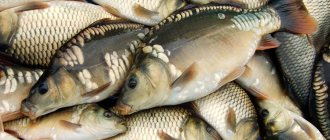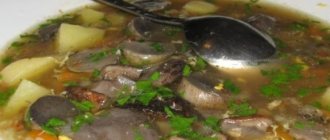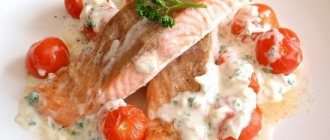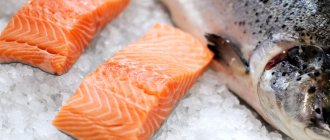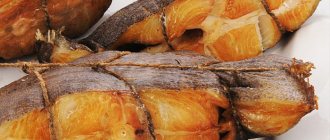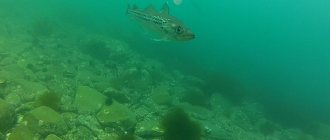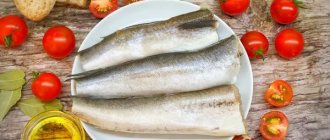Since that time, artificially bred fish have been called carp. After the carp began to be artificially grown, it moved from unnatural reservoirs and began to populate wild reservoirs, starting from the expanses of Eurasia. So it settled in virtually all bodies of water in the world.
What kind of fish is carp?
This representative of the underwater world is considered an omnivorous fish. To catch it, baits of different origins are used. In most cases, he selects areas of the water area where there is no rapid current and the bottom is clayey. Loves warm water and breeds at temperatures of about 18 degrees. And yet, it successfully inhabits reservoirs with cold water, or rather reservoirs that are covered with ice for the winter. You won’t find it closer to northern latitudes.
The diet of carp consists of mollusks, crustaceans or worms. For the most part, 3 types of carp have taken root in our reservoirs: scaly, mirror and naked.
Despite the fact that carp are also divided into species, depending on the nature of the body cover, the presence of bones and the shape of the body, an inexperienced fisherman or cook can easily confuse carp with crucian carp.
What to combine fish with in cooking
Regardless of country or nationality, everyone loves carp. It is prepared in different ways: baked, fried, boiled, stewed and stuffed. And what kind of fish soup does this fish make? There is, as they say, a spoon in it. In Central Asia, fish is cooked in white wine with dried fruits and almonds, and in Australia - with tomatoes, anchovies, bacon and cream. In Russian cuisine, stuffed carp is often prepared using mushrooms, bell peppers, garlic, ginger, eggs and onions. Lemon juice is harmonious for marinating fish. You can also use tomato. Since fish absorbs spices very actively, there is no need to be zealous with them. You can replace salt with soy sauce. Fish with basil, marjoram and cardamom reveals itself very interestingly. As a side dish you can serve fried potatoes, vegetables, rice, beans and buckwheat.
Even fried carp is allowed on the diet. Its calorie content, if cooked without oil, decreases significantly. Of course, a special grill pan will come in handy. First you need to remove the skin and fat deposits on the abdomen.

Calorie content of carp

When preparing a particular dish, be interested in the calorie content of the original product. This is especially true if the direction is taken towards a healthy lifestyle, without excess weight.
| Type of processing | Calorie content | Weight |
| Fresh | 112 kcal | 100 grams of product |
| Fried | 196 kcal | |
| Boiled | 102 kcal | |
| Baked | 124 kcal |
Nutritional value of the dish
Fish is one of the main products that should always be in our diet. And all thanks to the composition. Carp is not only a source of phosphorus and iodine, but also such vitamins (A, representatives of group B, vitamins E, PP), various mineral components: nickel, manganese, cobalt, sodium, chlorine, fluorine, molybdenum, etc.
As for the balance of BJU, these indicators depend on the products used in the cooking process. Below we offer the values of some carp dishes (per 100 grams of product):
- Fresh carp – 16.0/5.3/0.0 g
- Mirror – 16.00/5.3/0.33 g
- Baked with mustard and mayonnaise – 15.51/6.8/0.45 g
- Carp soup – 4.5/2.4/1.0 g
- With vegetables in a slow cooker – 8.4/5.8/4.2 g
- Baked with sour cream and onions – 11.3/5.0/2.8 g
- Canned – 13.6/8.7/1.4 g
- Nutritional value of baked with vegetables – 11.0/7.1/3.7 g
- Marinated – 13.6/8.7/1.4 g
- Fried fish (in a frying pan) – 18.3/11.6/4.5 g
- Baked with mustard – 13.9/7.2/0.9 g
- Fish cabbage soup – 2.7/1.9/1.6 g
- Fried with onions – 12.89/5.64/3.49 g
- Steam – 15.81/5.24/0.04 g
- According to the Korean recipe – 15.1/5.37/02.72 g
- Fish with garlic sauce – 12.9/13.96/0.7 g
- Boiled – 16.0/3.7/2.0 g
- Fish soup with tomatoes – 2.8/1.3/1.6 g
- Caviar – 28.00/10.00/0.00 g
- Smoked fish – 16.0/5.3/0.0 g
- Dried version – 17.70/1.80/0.0 g
- Fried in flour – 22.00/14.00/0.0 g
- Cooked in foil in the oven – 11.98/6.83/3.36 g
How to choose fresh carp
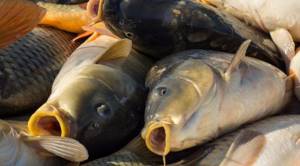
Because carp is bred artificially without any trouble and grows quickly, carp dishes are present on many ceremonial tables. Regardless of this, special attention should be paid to the quality of the initial product, since the level of quality of the final product depends on this.
In order to choose a product that has not spoiled, pay attention to:
- Condition of the gills. Their color can indicate how fresh the product is. The gill plates should have a fresh, red-pink hue. If the gills are stuck together and do not have a natural shape, then this is evidence that the product is broken.
- On the eyes. Transparent bulging eyes indicate that the product is fresh.
- The outer coverings should not have mechanical damage.
- When pressed, you should feel elasticity.
- If there is a suspicious odor, there is no need to take the fish.
- If there is quite a lot of blood on the fish’s body, it means that it is infected with some kind of disease.
Application
Carp is used in a variety of interpretations and conditions. Fried carp is extremely tasty. Its meat is soft and tender, with some sweetish undertones. Small bones are practically absent. Carp is fried in a large amount of sunflower oil and served with spices. Fried cap is an excellent appetizer and enjoys undeniable authority in the best restaurants in the world.
There are no contraindications for eating carp, although people with stomach or digestive problems should not overuse this fried product.
You should be careful when choosing fish. The mucus on the scales should not stick to your fingers, but be slippery. There should be no traces of blood on the body of the fish - this indicates that the carp was unhealthy. A small one-year-old carp is best suited for cooking, including frying. It is during this period that carp has the most delicious meat.
Market Analytics
- Black Lives Matter movement: reaction and consequences for the beauty industry
- COVID-19 is changing the rules of the game in the cosmetics market
- Beauty of the future: cosmetic innovations 2021
Convenient search for beauty salons on our website
Beauty salons in Moscow Beauty salons in St. Petersburg Beauty salons in Ekaterinburg Beauty salons in Novosibirsk
Latest blog posts on our website
- Naturecream / Tremella Extract - Snow Mushroom Detox for Skin
- Prostye-sovety / How to visually enlarge your lips with makeup
- Naturecream / Apricot kernel oil for face
- Naturecream / MATRIXYL3000 - the best skin elasticity stimulator
- Naturecream / SPF in Natural Oils
- Naturecream / Geranium (Pelargonium) oil for skin health and beauty
- Prostye-sovety / Save on a beauty salon: procedures that can be done at home
- Naturecream / Growth Factor - brings back youth?
- Oksana-Lezina / 3 effective abdominal exercises from a fitness instructor for beginners
- Prostye-sovety / Making perfect curls at home
Latest forum topics on our website
- Natalya / How to properly make a gelatin mask?
- Mrs._Smith / Badly sunburned! What to do?((
- Ice / Is it necessary to combine fitness classes with a diet?
- Antonova / What can be used for hair loss?
- Radio operatorKat / Who was on a protein diet?
Other articles in this section
| Fresh sea perch In nature, sea perch is found mainly in the Atlantic and Pacific oceans and belongs to the scorpion fish family. It prefers cold temperatures and depths of more than 100 meters to live. |
| Hot smoked pink salmon Pink salmon belongs to the salmon family. It has a light blue color. In addition to the dorsal fin, it also has an additional one - it is located between the dorsal fin and the tail. Another distinguishing feature is its mouth is white, it has no teeth on its tongue, and spots are marked on its back. Pink salmon live in cold water, and at temperatures above 25 degrees, pink salmon die. It is found in the Pacific and Arctic Oceans, in the rivers of Northern California, Canada, Siberia and Korea. Pink salmon spawn in August, so the fish should enter the river in July. She makes a nest herself, where she marks her eggs. The fry are born in November, and only in May-June do they leave the nest. By the time the fry reach the sea, most of them are usually eaten by predators. |
| Fried sturgeon Sturgeon belongs to the fish that are considered the most ancient on Earth. Scientists have a lot of evidence that this type of fish lived during the existence of dinosaurs. Representatives of sturgeon live in Asia, Europe, and North America. But the largest number is found in the Russian seas - the Caspian, Azov and Black. There are quite a lot of this fish in the Ob, Volga, Lena, Kolyma, Amur rivers, and Lake Baikal. Some specimens have an average length of up to 2 meters and a weight of 50 to 80 kg. The meat of any type of sturgeon is tender and tasty. There are many recipes for cooking, but it is especially tasty fried or baked. |
| Boiled halibut Halibut is a delicious sea fish belonging to the flounder family. A peculiarity of the fish is the location of both eyes on one, right side of the head. |
| Salted chum salmon As a member of the salmon family, chum salmon prefers the cold waters of the northern seas. This is probably the most popular fish in regions such as northern Russia and the Far East. The spawning period most often takes place at river mouths. Interestingly, for chum salmon the spawning period is an extremely important moment. Most individuals die after laying eggs. Caviar of this type is a very valuable product and quite expensive. |
| Boiled burbot Burbot is a fish belonging to the cod family. He is considered the only representative of the species that has adapted to life in freshwater bodies. Prefers to live in cold and clean running water with a temperature no higher than 13 degrees. Its distribution area is considered to be rivers and lakes in Europe, North America and Siberia. Moreover, in cold Siberian reservoirs with a sandy rocky bottom, commercial catches of burbot are carried out. Being a typical representative of cod fish, burbot grows slowly. Adults grow up to 120 cm and weigh 25 kg. |
| Saury blanched in oil Saury is a sea fish that lives in the waters of the Pacific and Atlantic oceans. Saury belongs to the Makreleshchukov family. This fish has an elongated body with silvery scales. The back of the saury is quite dark in color. The length of saury reaches 40 cm, while the weight does not exceed 200 grams. The main food of fish is plankton. |
| Salted pink salmon Pink salmon belongs to the salmon family. Its unusual name comes from the hump that appears on the backs of males during the spawning period. Habitat: fresh water bodies in cold climates, seas. Pink salmon belongs to the “red fish”, contains a large amount of microelements and fat-soluble valuable vitamins, and is in wide demand because it has a relatively affordable price. To get truly tasty meat, you need to catch this fish at the right times, because during spawning it is not at all tasty. |
| Baked catfish Catfish, often called “sea wolf,” is a marine fish belonging to the perch family. It is usually found in the Pacific Ocean and the Atlantic, namely in those places where the water does not warm above +14 degrees. |
| Stuffed pike Pike is a freshwater fish. One of the most popular in cooking. Pike dishes are tasty, nutritious, healthy and dietary. A festive table setting is not complete without culinary masterpieces using this fish. |
Carp: benefits and harm

What makes seafood different is that it contains a whole bunch of vitamins and microelements. Fish in particular is an irreplaceable product that can ensure the normal functioning of the human body. Regular consumption of fish can help:
- Improving health by replenishing it with the necessary vitamins and minerals.
- Possibility of extending life by blocking free radicals with antioxidants.
- Increased efficiency and productivity, regardless of the nature of the work: mental or physical.
- Decreased blood sugar levels. This indicates that carp is recommended for use by patients with diabetes.
- Improving the functioning of the gastrointestinal tract, while accelerating metabolism.
The main contraindication is excessive consumption of the product. The extra pieces you eat will not do any good. The human body will take as many necessary substances as it does not produce. Also, there is such a thing as a balanced diet. In other words, the diet cannot consist of only one fish, unless it is necessary and contains so many necessary components. In any case, it is better to rely on gastronomic preferences.
Choosing how to cook carp
Fried carp will be the hardest for the body. Its calorie content reaches almost 200 kcal per 100 grams. And if you add the fact that fatty fish increases cholesterol, then its consumption may be undesirable. But fish oil is much more valuable than pork or beef. Due to the presence of minerals and vitamins, carp meat becomes useful for stabilizing the functioning of the body in general and the musculoskeletal system in particular.
So, for those losing weight, eating carp is beneficial, because this meat stimulates metabolism.
It is best to buy carp alive and not look at very large carcasses. The ideal would be a fish weighing 1-1.5 kg with red-pink gills, elastic meat and a moist, smooth tail. Purchased carp can remain in the refrigerator for up to three days. Just don’t forget to gut it, put it in a glass container and cover with film. Carp does not lose its quality in the freezer. The calorie content per 100 grams of fish does not change.

For example
So, on the menu is carp in the oven. We keep its calorie content as low as possible so that you can easily afford fish for dinner. Clean the carcass from the insides. In a separate saucepan, combine soy sauce with basil, onion and garlic. Add lemon juice and a few tablespoons of mustard. Mix everything and leave the fish in the cold.
You can also chop the nuts and fry the carrots in a frying pan. Next, stuff the carp with carrots and boiled buckwheat, and prick the belly with toothpicks so that nothing falls out. Now line the baking tray with baking paper. When laying out the fish, pour the marinade generously on top and place in the oven.
Composition of fresh carp
Carp contains a large number of vital elements. It is valued for the fact that it contains easily digestible protein.
Nutritional value of carp, per 100 g:
| Name | quantity |
| squirrels | 15.879 g |
| fats | 5.284 g |
| carbohydrates |
Content of vitamins in carp, per 100 g:
| vitamin | quantity |
| A | 19.8 mcg |
| IN 1 | 0.137 mg |
| AT 2 | 0.053 mg |
| AT 4 | 64.836 mg |
| AT 5 | 0.186 mg |
| AT 6 | 0.168 mg |
| AT 9 | 9.288 mcg |
| AT 12 | 1.447 mcg |
| WITH | 1.489 mg |
| D | 24.687 mcg |
| E | 0.491 mg |
| TO | 0.097 mcg |
| RR | 5.492 mg |
Content of macroelements in carp, per 100 g:
| macronutrient | quantity, mg |
| potassium | 266,1 |
| phosphorus | 209,34 |
| sulfur | 179,81 |
| sodium | 54,9 |
| chlorine | 54,89 |
| calcium | 34,78 |
| magnesium | 24,77 |
Carp holds the record for the amount of phosphorus; it contains almost the same amount of this element as sturgeon.
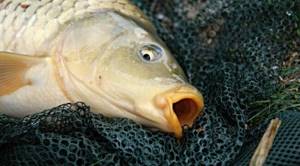
Content of microelements in carp, per 100 g:
| trace element | quantity |
| zinc | 2.07 mg |
| iron | 0.78 mg |
| manganese | 0.15 mg |
| copper | 129.84 mcg |
| chromium | 54.67 mcg |
| cobalt | 34.91 mcg |
| fluorine | 24.88 mcg |
| selenium | 12.57 mcg |
| nickel | 6.87 mcg |
| iodine | 4.82 mcg |
| molybdenum | 3.98 mcg |
In addition, 100 g of carp contains the following elements:
- Omega-3 – 0.054 g;
- Omega-6 – 0.284 g.
By regularly eating dishes prepared from carp, you can saturate your body with the necessary elements.

